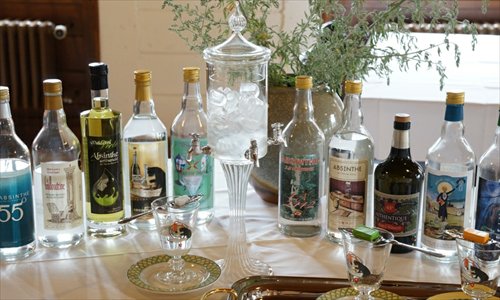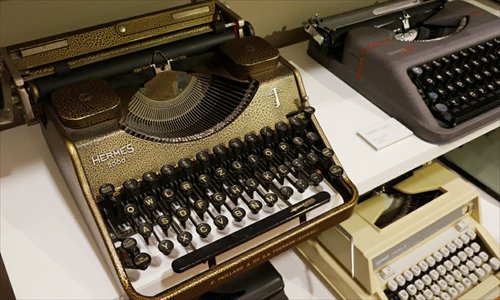HOME >> LIFE
Swiss wonderland
By Sindy Chan Source:Global Times Published: 2015-3-13 5:03:02
A visit to Sainte-Croix, Switzerland

Creux du Van - the "Swiss Grand Canyon" near Sainte-Croix Photo: Sindy Chan

A man shows off a Bolex 16 millimeter camera. Photo: Sindy Chan

A set for drinking absinthe sits on a table at the Hotel de France. Photo: Sindy Chan

Hermes typewriters are on display at a temporary exhibition in the Musée des Arts et Sciences.
The first day we arrived in Sainte-Croix, we planned to do some uphill hiking. As we walked along we ended up finding ourselves in a kingdom of little brown-shelled and white-bodied creatures scattered on both sides of grassy muddy trails.
"Aha! French snails!" My husband Troy exclaimed. "We must be very close to the French border."
When we got back to the Hotel de France, the owners Marina and Rolf confirmed that the wild snails we saw were a protected relative belonging to the family of the familiar land snails that are served in fine-dining restaurants.
Sainte-Croix, nowadays a hidden spot in the Yverdon-les-Bains region of western Switzerland, is a French-speaking town most-visited by German-speaking Swiss and European travelers.
For international visitors arriving in Switzerland in Geneva or Zurich, it takes about two and a half hours by train to reach the mountain town of Sainte-Croix. To get there we used our Swiss Pass, which pretty much can get you anywhere in the country.
People go to Sainte-Croix for very special reasons, among them are visitors who make appointments for the world-famous Leu Family Iron workshop to get a tatoo. The place is so famous it even draws visitors from around the globe as far away as China.
Not a big fan of tatoos? How about a selfie in front of the humble Leu Family house, where Filip Leu - head of the tatoo shop and as grandson of Sean Tinguely (1925 - 1991), the Swiss painter and sculptor known for his kinetic art (or sculptural machines) - makes his home.
Sainte-Croix is an artist town. At the Hotel de France's Bistro 77, the rendezvous for local artist and craftsman, we met Bastien Chevalier, a young marquetry master who comes to the bistro everyday for espresso or wine.
Despite the fact that Bastien spoke French and I spoke English, we managed to communicate by bits and pieces. From what I understand from Bastien, it took him a total of 20 years of study and apprenticeship to run his own workshop.
Marquetry started as a overlaying craft practiced by the ancient Babylonians and Egyptians. Italians made the art flourish through their wide use of veneers, or thin sheets of wood, to decorate furniture.
I made a bold request to visit Bastien's workshop the next day for an up-close-and-personal look. His dainty, exquisite marquetry pieces of artful landscapes, flowers, birds, natural scenery and human faces in vivid colors were put together flawlessly. It must have taken extremely fine craftsmanship to mix and match the natural colors of different veneers from exotic woods to make those masterpieces.
"A young artist doing antique art - what a wonderful job you have, Bastien," I told him as I looked on in amazement.
Mechanical Masterpieces
For more than a century, Sainte-Croix was the leading manufacturing town in Switzerland. The building complex (now a shopping mall and supermarket) overlooking the Sainte-Croix railway station used to house world-famous manufactures of big Swiss-made brands such as the Hermes typewriter, Bolex camera and Reuge music box. However, while the typewriter has been taken over by computers and mechanical cameras have succeeded by digital technology, Reuge's mechanical music boxes live on.
To me, the Paillard family home has to be one of the most important addresses in Sainte-Croix. The founders of E. Paillard & Company, the family started their small manufacturing business on the ground floor of their home. From there this family business grew into one of the world's biggest companies at the time, producing the Hermes typewriter and Hermes Baby portable typewriter, once the most fashionable and overwhelmingly popular pieces of equipment used by novelists such as Ernest Hemingway, journalists and celebrities.
While visiting a temporary exhibit at the Musée des Arts et Sciences in Sainte-Croix, I was deeply touched to learn from museum volunteer Jean-Samuel that the entire exhibition containing more than 100 Hermes typewriters were donated by a single family over three generations.
The birth of the first typewriter is a beautiful story. It was created in the 18th century for a blind countess to help her write and communicate with friends and family. Later, however, this idea born from kindness was transformed into a huge commercial success story that lasted all the way until the age of personal computers.
Bolex is another big name in Sainte-Croix. The Bolex Company was first founded by Jacques Bogopolsky in 1927 and sold to Paillard in 1930, after which it grew and became a world leader in the production of mechanical motion picture cameras. Filmmakers such as David Lynch, Steven Spielberg and Spike Lee all began their early careers using a Bolex 16 millimeter or super 16 millimeter camera.
Even after the film industry turned to digital, Bolex has continued to succeed with its mechanical cameras, as the temperature resistance of these cameras has yet to be surpassed by digital technology.
We took a 40-minute train ride from Sainte-Croix to Yverdon-les-Bains to visit Bolex's current manufacturing and office center where we met Marc Ueter and Otello Diotallevi.
"We still build and service Bolex cameras," said Marc Ueter, a second generation member of the company's owning family.
"We have technical people, like Mr. Diotallevi, who have been with us for more than 30 years," Ueter added.
I imagine Ueter must be very proud of what his father did in 1981. René Ueter was a Bolex manager at the time who managed to save Bolex by securing funds from the bank and bringing Bolex back from the brink of bankruptcy.
Do you know what the hometown of those mechanical singing birds in cages is? Sainte-Croix of course!
At the turn of the 20th century, Sainte-Croix had 600 workers employed in over 40 companies to produce mechanical singing birds and musical automatons.
The little village was the capital of mechanical music in Switzerland back when the music box industry accounted for almost 10 percent of Switzerland's exports.
Reuge, another baby of Sainte-Croix, has stood the test of time to remain a quality brand of mechanical music boxes.
The Centre International de la Mécanique d'Art of Sainte-Croix has some of the world's most historic music boxes. In the museum's affiliated workshop, volunteer Theodor Hart took us on a guided tour for a closer look at the tools, a huge collection donated by the late Dr. Jurg Wyss, used in making these handmade music boxes.
During my visit I couldn't take my curious eyes off of the 85-year-old Reuge factory building - a time machine and living museum of Sainte-Croix. So I asked Marina and Rolf's help to arrange a factory visit, which they did!
In 1886, Albert Ruege opened a music-box shop in Sainte-Croix and quickly turned the family workshop into a small factory producing music pieces. From that point on Ruege music boxes became an integral part of Sainte-Croix's glorious mechanical industry. Although Ruege is no longer the same family business it was 150 years ago, the legend lives on.
"Music boxes are a fine mechanical art and craft, a gift meant to last for generations," Ruege CEO Kurt Kupper said as he explained the essence of mechanical music to us.
Because of the company's dedication, these eternal singing birds are decorated with genuine bird feathers, while music box cylinders and combs are made with a level of precision beyond our imagination.
I asked Kupper what his favorite piece was and he showed me a music box of modern design that also serves as a mobile phone charger. When it receives an incoming call, the music box sings.
"I like the idea that mechanical music is not just an ancient art but also an ever-growing technology," Kupper said.
Green dreams
The artistic town of Saint-Croix is also a place that is experiencing the revival of that mystical drink absinthe, an aperitif that used to contain psychedelic ingredients during the 19th century and so carries the nickname "green fairy."
Some people believe that gifted artists as Vincent van Gogh were very fond of this strong - 77 percent alcohol by volume - beverage. Many believe that van Gogh cut off his ear while caught up in a hallucinatory state caused by absinthe.
According to Marina, absinthe was prohibited for many decades and legalized again in 2005 after which is has steadily became popular in Switzerland, France and Italy.
The absinthe we had at the Hotel de France was from small distilleries in nearby villages, brewed with a new recipe that contained no psychedelic ingredients.
While some of the ingredients have changed, the ritual that goes along with drinking absinthe does remain. Ice is put in a cylinder filled with water, a wine glass with a sugar cube on a spoon-sieve is placed under the cylinder tap and ice-water from the cylinder drips down to mix with sugar to become syrup. This syrup then turns the absinthe a milky color, which let's you know it's ready to be served.
My husband Troy had a glass of 56 percent absinthe, yet experienced no hallucinations or artistic inspiration to paint a sunflower.
Along the gentle slopes of the Jura mountains between Sainte-Croix and Noiraigue lies Creux du Van, a half-an-hour drive from Sainte-Croix. Local people call it the "Swiss Grand Canyon." The imposing rocky cirque of Creux du Van provides a different perspective of the land and leaves a lasting impression on every visitor to Sainte-Croix.
The night before we left, I looked up to the clear sky. It reminded me of Sainte-Croix, a plain and clear entrepreneurial town that doesn't look that glamorous, but holds a lot of substance just waiting to be discovered by visitors.
Posted in: Feature